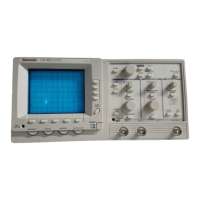TAS 200 Series Adjustment Procedures
32
Bench Test Instruments and Handheld Oscilloscopes Basic Service
3. Set the C H 2 VERTICAL INVERT push switch to the in position and note
the new trace location.
4. On the Main board, adjust VR213 to position the trace half way back to the
center horizontal graticule line. S ee Figure 8 for the adjustment location.
5. Set the channel 2 VERTICAL INVERT push switch to the out position.
6. If the trace shifts, adjust VR 303 to return the trace to the center horizontal
graticule line.
7. Repeat steps 3 through 6 to obtain a minimal trace shift (<±1 division) when
you toggle the C H 2 VERTICAL INVERT push switch in and out.
Use the following procedure to adjust the ADD mode balance.
1. Set up the oscilloscope as follows:
VERTICAL MODE BOTH
CH 1 (CH 2) VOLTS/DIV 10 mV
CH 1 (CH 2) VARIABLE CAL
CH 1 (CH 2) GND In
2. Position both traces on the center horizontal graticule line using the CH 1
and CH 2 VERTICAL POSITION controls.
3. Set the VERTICAL MODE control to the ADD position.
4. On the Main board, adjust VR301 to position the trace on the center
horizontal graticule line. S ee Figure 8 for the adjustment location.
5. Set the VERTICAL MODE switch to BOTH, CH2, and then CH1; verify
that the trace shifts less than ±1 division from the center of the display. If
necessary, repeat steps 2 through 4 to obtain the best performance.
Use the following procedure to adjust the vertical gain.
1. Set up the oscilloscope as follows:
VERTICAL MODE CH1
CH 1 (CH 2) VOLTS/DIV 10 mV
CH 1 (CH 2) VARIABLE CAL
CH 1 (CH 2) AC-DC DC
2. Connect a 50 mV
p-p
50 kHz square wave to the CH 1 and CH 2 inputs with a
dual input coupler.
3. On the Main board, adjust VR108 to obtain a waveform five divisions in
amplitude. See Figure 8 for the adjustment location.
ADD Mode Balance
Vertical Gain

